Eggs Benedict is the bona fide grande dame of Sunday brunches around the United States. Most of us can’t remember a time when it wasn’t offered on virtually every breakfast menu. The time-honored Eggs Benedict are quite simple. Ingredients can vary but it is always comprised of four components – bread, meat, eggs, and sauce. Any or all of these can be adjusted to meet your individual tastes. Traditionally an English muffin is split and toasted, layered with a slice of warmed Canadian bacon, and then a softly poached egg. All of this is topped with a generous portion of hot hollandaise sauce. Delightful and decadent, it is no wonder it is so popular.
The actual recipe creation is obscured by time, but it most likely started in New York City. There are two generally accepted possibilities. The first is that an esteemed patron of Delmonico’s Restaurant requested something new to eat for lunch and the chef, Charles Ranhofer, devised and presented the combination of muffins, ham, eggs, and Hollandaise sauce to the delighted patron. The second states that a hung-over stockbroker from Wall Street went into the Waldorf Astoria Hotel and told the legendary chef, Oscar Tschirky to put together some toast, crisp bacon, two eggs and Hollandaise sauce. Supposedly Chef Tschirky liked the idea so much that he put it on his regular menu, substituting Canadian bacon for the regular bacon and an English muffin for the toast. No matter who came up with it, it will forever be one of this country’s prized breakfast and brunch offerings.
English muffins were originally made from leftover bread and biscuit dough scraps combined with mashed potatoes. When fried on a hot griddle, they become a light, crusty muffin that is addicting. For muffins with the deep “nooks and crannies” that we all love, the dough is so soft it is almost a batter. When made this way you will need “muffin rings” that you can buy in kitchen supply stores. Cover your cooking surface with cornmeal so they won’t stick.
Canadian bacon is a term referring to smoked or unsmoked boneless eye of pork loin. It is much less fatty than regular bacon and a great option if you are trying to watch your calories. Of course the hollandaise wipes out any advantage, LOL. You can also use a slice of ham or a couple slices of cooked bacon. For those who are avoiding meats, you can substitute cooked spinach, a thick slice of tomato, some smoked salmon, or even a grilled portabello mushroom.
Poached eggs are not required, but Benedict just wouldn’t be the same without breaking into a perfectly poached egg and watching the yolk flow out and merge with the hollandaise sauce. For those who don’t like soft eggs, you can of course cook them longer, or even scramble them. If you are serving people who hate eggs – as hard as that is to believe – you can leave them out or substitute something else such as potatoes or grilled vegetables. In California it is common to see Crab Benedict on the menu, where a beautifully cooked crab cake is used in place of the Canadian bacon. This is so rich and sumptuous that no one would miss the eggs!
If you want to make Eggs Benedict for a crowd, the perfect solution is my make-ahead casserole that you can put together the night before and refrigerate. Bake it off in the morning while you make the hollandaise and you’ll have all the flavors of Benedict without any last minute preparation required. Your guests will be suitably impressed and you should be prepared for a round of applause when you serve breakfast!
Hollandaise sauce is one of the five French master sauces that every chef learns in culinary school. Made with egg yolks emulsified with butter, a touch of lemon juice and cayenne pepper, it is the base for several other sauces including Bearnaise, Mousseline, and Maltaise. It is a classic that can be used in many ways, and is certainly not limited to just Benedict! Here’s a bit of fun trivia for you … Hollandaise was originally called Sauce Isigny after a town in Normandy which was known for its butter. During World War I butter production was halted in France and it had to be imported from Holland (now called The Netherlands). Thus the sauce was renamed Hollandaise which means Holland-style.
If you are making your hollandaise from scratch, one of the ingredients is clarified butter, known as Ghee in South Asian cultures. It is made by slowly simmering unsalted butter until all the water is evaporated and the milk solids have settled to the bottom of the pan. Then you skim away the froth that gathers on the surface. What is left is pure butterfat which can be stored in an airtight container at room temperature for a long time without spoiling. With the milk solids removed, it is difficult to burn the butter, raising the smoke point and allowing cooking at higher temperatures. Using Ghee is another way to make a homemade hollandaise easier and quicker to make. While not absolutely required for a good hollandaise, you can buy Ghee at many grocery stores and will usually find it in the “foreign foods” aisle.
The biggest challenge to hollandaise is emulsifying the egg yolks and butter and keeping them blended. Some people add a little mustard which does help keep the sauce from breaking (separating). If you are uncomfortable with making the sauce from scratch or don’t have the time and patience necessary, there is an excellent option available. Knorr makes a wide range of products, all with extremely high quality standards. I have used their sauce mixes for years and they are my go-to when I am short of time. The added benefit is that you don’t have to worry about food safety because the eggs have been pasteurized, so this sauce and sit on a warm stove for a long time without any concern.
A note about food safety… Hollandaise can go bad after 3 hours and the average brunch is usually 4 to 6 hours long. Unless I am eating within two hours of the start of brunch service, I won’t order Eggs Benedict. You can’t guarantee that the restaurant kitchen is throwing the sauce away every 3 hours and replacing it with a fresh batch. While there is probably no danger, I prefer to stay on the safe side. There are always many delicious offerings on the menu and I will choose something else if we are eating toward the end of service.
Don’t limit yourself to just thinking of brunch when you consider these recipes. Cut into small squares, these would be a lovely appetizer for cocktail parties or as part of a buffet. You could serve the sauce on the side, in a bowl with a small ladle so that your guests could choose the amount they wanted. For a lovely breakfast or brunch, serve your Benedict with freshly sliced seasonal fruit on the side. Try to include some that are on the crunchy side such as apples or pears for nice textural variety. A tossed green salad dressed with a raspberry vinaigrette would add a lot of color to the plate and the acidity of the dressing would balance the richness of the hollandaise sauce. If you want to offer a sweet treat, my Pecan Raisin Coffee Cake would be perfect.
Enjoy your weekend and Happy Festive Friday!
Jane’s Tips and Hints:
Adding a little vinegar to the cooking water helps egg whites coagulate quickly and gives you perfectly poached eggs. If you keep the water just below a simmer, with bubbles around the edges, the eggs will
Kitchen Skill: How to Fix a “Broken” Sauce
If the eggs and butter are no longer emulsified, that is called “breaking.” To fix this, combine 1 egg yolk with 2 tbsp water in a clean bowl over barely simmering water. Slowly whisk in 3 to 4 tbsp of melted clarified butter.
When smooth and slightly thickened, start adding the broken sauce, a little at a time, to the newly made sauce, continuously whisking briskly until completely incorporated and the sauce is smooth and silky. Take the bowl on and off the heat as needed to maintain a stable temperature.
Serve immediately or hold on warm heat for up to 2 hours.
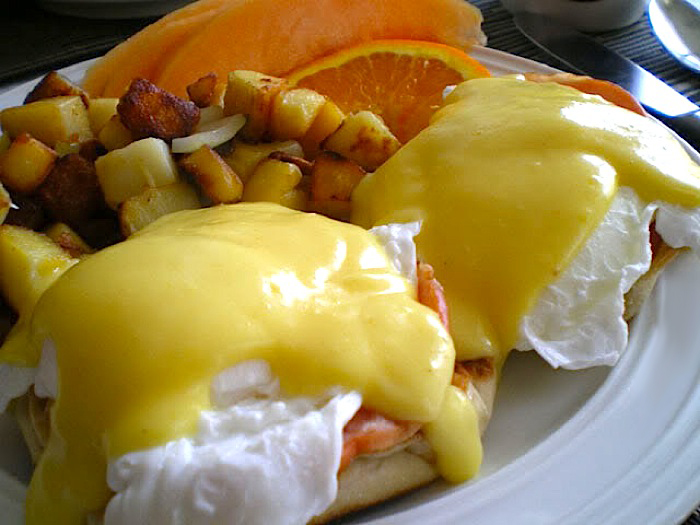

- 6 English muffins, split and lightly toasted
- 12 slices of Canadian Bacon, warmed
- 12 large eggs, poached
- Warm hollandaise sauce, homemade or from a Knorr mix
- Minced fresh chives
- Lightly toast the English muffins and place two halves on each warmed plate or shallow bowl. Top each half with a slice of Canadian bacon and a hot poached egg. Pour some hollandaise sauce over each and sprinkle with minced chives. Serve immediately.
- Water
- 1 to 2 tsp salt
- 3 tbsp white vinegar
- 12 eggs
- Heat about 3 inches of water in a large saucepan with straight sides over medium heat to a simmer. Stir in vinegar.
- Crack each egg into individual small bowls or cups. Slide eggs, one by one, from the bowls into the simmering water, cooking no more than 4 per batch. Maintain the water just below a simmer, reducing the heat to low if necessary. Bubbles around the sides of the pan are fine but there should be no bubbles that break the surface of the water.
- Cook until the whites are set and the centers are still soft, about 3 minutes. Remove eggs with a slotted spoon, tap bottom of spoon on a clean kitchen towel or paper towel, and place in small warmed bowls, cups or ramekins.
- To Cook Ahead: Cook as above but when you remove eggs from hot water, place them in a bowl of cold water to stop the cooking. You can keep them in the water for a few hours, covered, in the refrigerator.
- Bring a pot of lightly salted water to a boil, reduce the heat and hold at just below a simmer. It should be steaming hot.
- When you are ready to serve, carefully transfer eggs to hot water and re-warm for about 30 seconds or until heated through. Remove from hot water with a slotted spoon, tap bottom of spoon on a clean kitchen towel or paper towel to get rid of extra water, and serve.
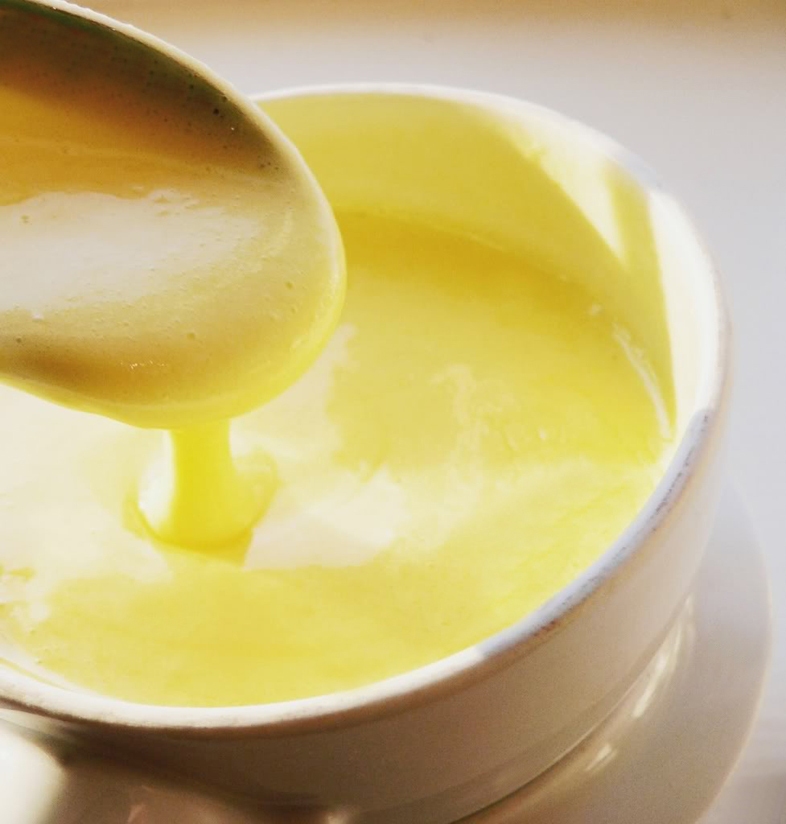

- 3 large egg yolks
- 2 tsp freshly squeezed lemon juice
- 1 tbsp cold water
- 1 tsp kosher salt
- Pinch cayenne pepper
- 1-1/2 cups clarified butter, about 3 sticks of butter (see below for directions)
- Whisk egg yolks, lemon juice, water, salt, and cayenne in a medium stainless steel or glass bowl to blend. Place bowl on top of a saucepan filled with about 2-inches of barely simmering water – do not let water touch the bottom of the bowl.
- Whisk constantly until thickened lightly, and an instant-read thermometer inserted into mixture registers 160°F, about 5 minutes. Transfer yolk mixture to blender or food processor. With motor running, gradually pour hot melted butter through opening in top and blend until mixture is thick and creamy. Taste and adjust seasoning with additional salt or cayenne as desired.
- Yield: about 1-1/2 cups
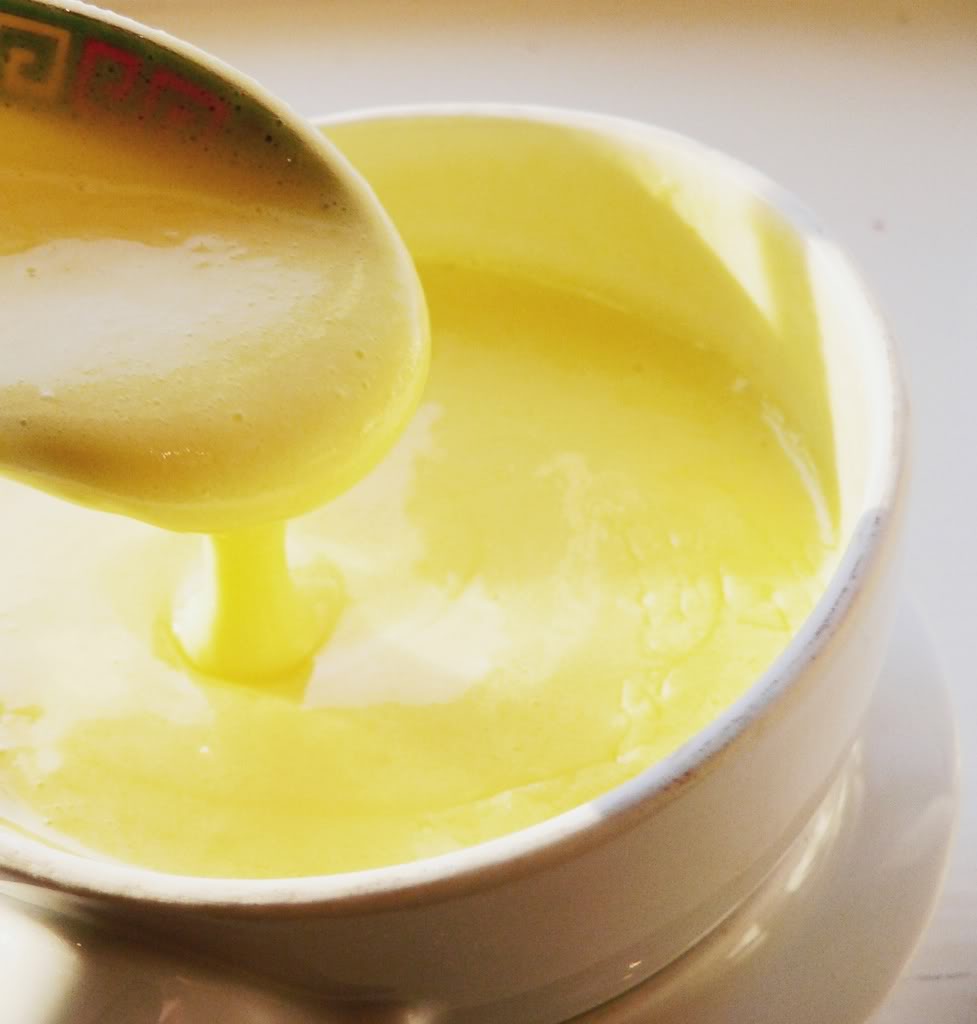

- 1/2 tsp cracked peppercorns
- 1/4 cup white wine or cider vinegar
- 1/4 cup water, or as needed
- 4 large eggs, fresh or pasteurized
- 1-1/2 cups melted or clarified butter
- 2 tsp lemon juice, or as needed
- 2 tsp salt, or as needed
- Pinch ground white pepper
- Pinch cayenne (optional)
- Combine the peppercorns and vinegar in a small pan and reduce over medium heat until nearly dry, about 5 minutes. Add the water to the vinegar reduction. Strain this liquid into a stainless steel bowl.
- Add the egg yolks to the vinegar reduction and set the bowl over a pot of simmering water. Whisking constantly, cook the egg yolk/vinegar mixture until the yolks triple in volume and fall in ribbons from the whisk. Remove the bowl from the heat and place it on a clean kitchen towel to keep the bowl from slipping.
- Gradually ladle the warm butter into the egg mixture, whisking constantly. If needed, have someone else either hold the bowl steady or pour in the butter. If the sauce becomes too thick and the butter is not blending in easily, add a little water to thin the egg mixture just enough to whisk in the remaining butter. Season the Hollandaise with lemon juice, salt, white pepper, and cayenne. Serve immediately or keep the sauce warm in a bowl over simmering water up to 2 hours.
- Yield: 2 cups
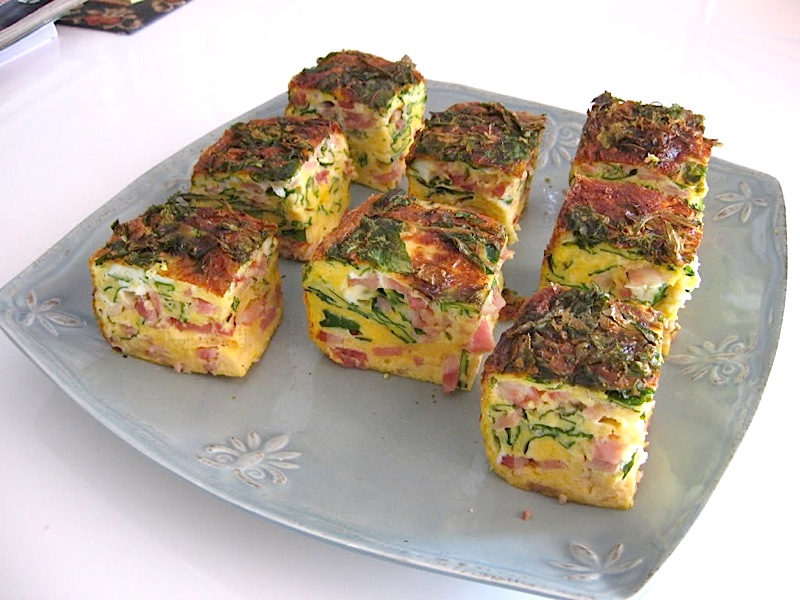

- 1 large onion, peeled and chopped finely
- 2 tbsp butter
- 6 English muffins (1 package), cut into 1/2-inch cubes
- About 12 oz Canadian bacon or cooked ham, cut into 1/2-inch cubes
- 10 large eggs
- 2 cups milk
- 1/2 tsp kosher salt
- 2 tsp dried thyme leaves
- Hollandaise sauce, for serving
- Minced fresh chives, for garnish
- Fresh thyme sprigs, for garnish
- Heat butter in a medium saute pan and cook onions until slightly softened, about 3 minutes. Remove from the heat and set aside to cool.
- Butter a 9×13-inch baking pan. Preheat oven to 375°F. Spread muffin cubes on a baking sheet and lightly toast for about 10 minutes, stirring occasionally, or until golden brown; set aside.
- In a large mixing bowl, whisk the eggs until well beaten. Whisk in milk, salt, and thyme leaves. Stir in cooked onions, muffin cubes, and Canadian bacon. Pour mixture into prepared baking dish. Cover with aluminum foil and refrigerate overnight, or at least 8 hours, to let bread fully absorb egg mixture. It will be very liquid when you put it in the refrigerator and fairly solid once the bread has absorbed the eggs.
- Remove casserole from refrigerator and bake for 40 minutes. Remove foil and continue to bake, uncovered, until the eggs are set and the top begins to crisp, about 20 minutes more. Be careful not to overcook or the eggs will be tough and rubbery. If using a glass dish, reduce the baking temp to 350°F or reduce the cooking time by about 10 minutes. When done, remove the casserole from oven and let it stand 5 to 10 minutes before serving.
- While casserole is baking, make or reheat your hollandaise sauce. To serve, cut casserole into squares and place on warmed plates or large, shallow bowls. Top each piece with warm hollandaise, sprinkle with chopped chives, and garnish with a couple sprigs of fresh thyme just before serving.
- If you are throwing a fancy brunch, you can bake the casserole as directed above, and when slightly cooled, cut it into small squares. You can rewarm them in a low oven, place on serving plates, and top with warm hollandaise. You can also make this casserole in individual servings. Divide the mixture evenly in large muffin tins, ramekins, or au gratin dishes. Adjust the baking time, cooking until they are puffed and golden.
Thank You!
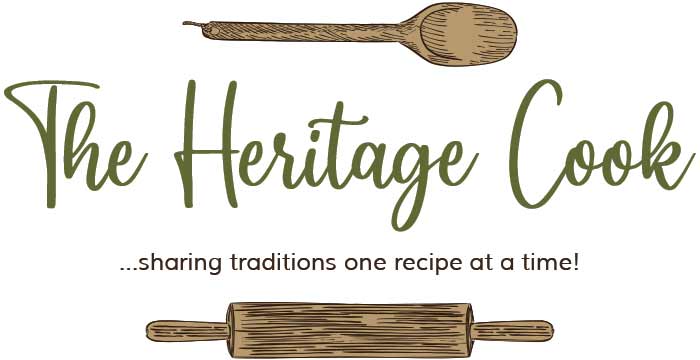

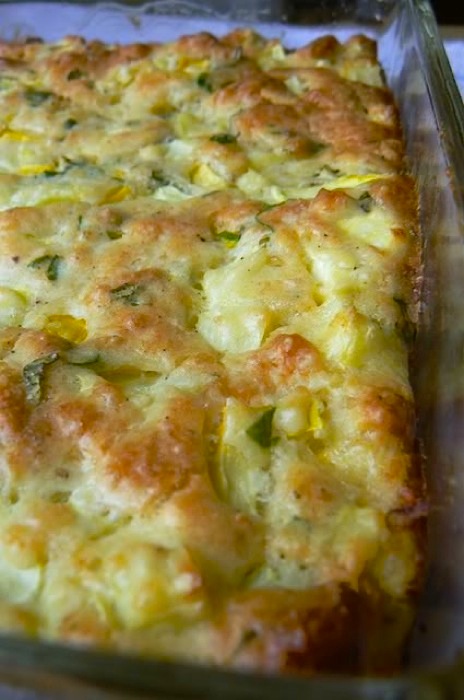
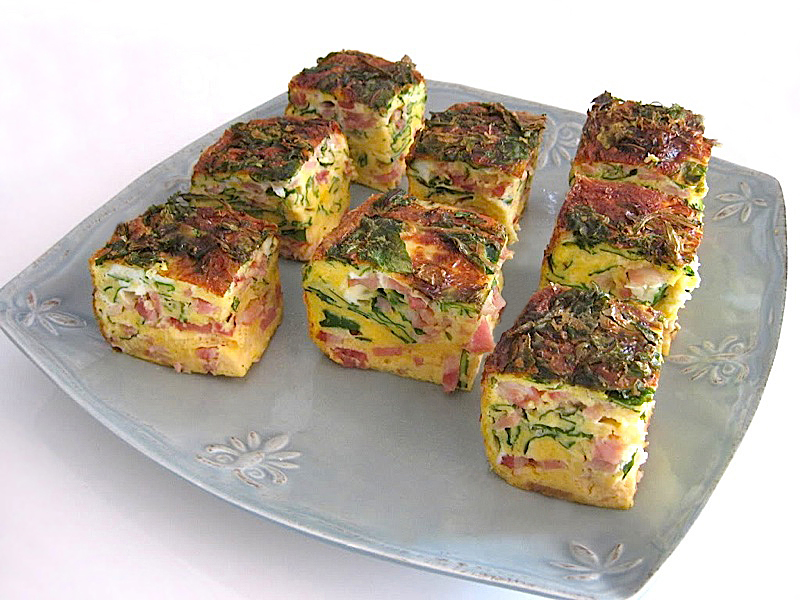


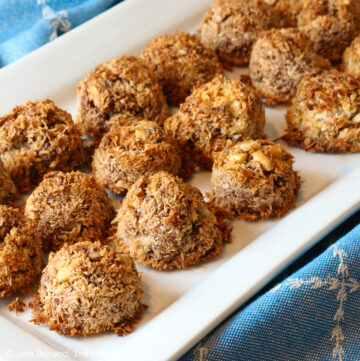
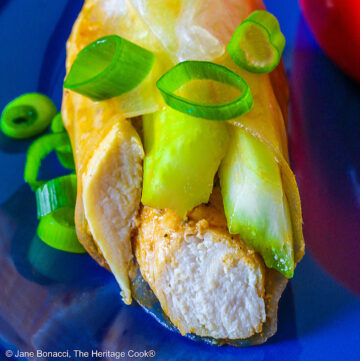
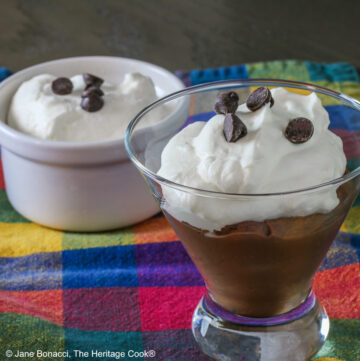

Beth
Have you tried freezing the eggs beneedict casserole before or after baking it? I’m considering making it ahead of time for Christmas.
Thanks!
Jane Bonacci
Hi Beth,
I have not frozen this dish because I usually make it the night before and let it rest in the refrigerator until the morning. A custard usually suffers from freezing, but with the bread in there it might work. You could prep and assemble all of the ingredients a day or two in advance and keep them in the refrigerator in separate containers. That would reduce your actual prep time to about 15 minutes the night before. I hope this helps!
Feast on the Cheap
That eggs benedict casserole is GENIUS! I can’t wait to make it, I order EB every time I go out for brunch, it’s one of my all-time faves.
Jane Bonacci, The Heritage Cook
I hope you like it. Remember that it will be like a savory bread pudding that you put the Hollandaise on… Still delicious, but texture etc will be a bit different. I love it and hope you do too!!